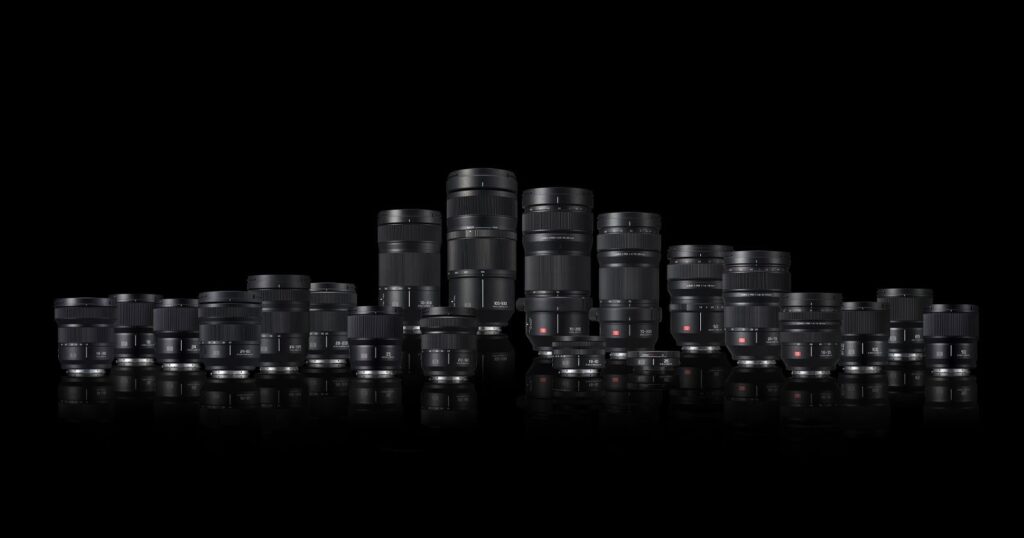
When Panasonic introduced its first full-frame mirrorless cameras in 2019, it was not entering uncharted territory. The company had already established a strong reputation among filmmakers with its GH series—compact Micro Four Thirds cameras known for their impressive capabilities. However, the S Series marked a significant departure, as LUMIX aimed to compete with leading lens manufacturers in the realm of full-frame photography and video.
Full disclosure: This article is sponsored by Panasonic LUMIX.
Central to this new venture was the introduction of the LUMIX S Series lenses. Developed in collaboration with the L-Mount Alliance—a partnership with Leica and Sigma—these lenses were designed to set new standards rather than merely fill focal range gaps. The lineup underscored a crucial insight for creators: while camera technology evolves rapidly, quality lenses remain long-term investments. For those who work across both video and photography, these lenses ensure consistent color, sharpness, and style from one project to the next.
The S PRO Series: Flagship Glass
S PRO 50mm F1.4: The Benchmark
The S PRO 50mm F1.4 was the inaugural lens of the series and continues to be a defining piece of the lineup. LUMIX engineers approached it as more than a standard “nifty fifty,” treating it as a master prime lens against which all other S-series lenses would be judged. This lens is renowned for its exceptional sharpness, capable of resolving detail for high-resolution cameras like the 44-megapixel S1RII. However, sharpness was not the sole objective. LUMIX also prioritized smooth, natural bokeh and faithful color reproduction, ensuring images appear clean and lifelike. It is a lens that quietly delivers images that resonate with authenticity.
S PRO 24-70mm F2.8: The Everyday Workhorse
The 24-70mm F2.8 is a go-to lens for professionals, prized for its consistency. It offers edge-to-edge sharpness, smooth background blur, and true-to-life color across its zoom range. The lens employs a double focus system—two groups of elements moving simultaneously—for quick, accurate autofocus. This system also reduces “focus breathing,” a feature appreciated by video shooters. It is a reliable workhorse, suitable for portraits, landscapes, events, and video.
Telephoto Zooms: Extra Reach
S PRO 70-200mm F2.8 O.I.S.: The Telephoto Staple
For action, sports, and portrait photography, the 70-200mm F2.8 O.I.S. is a staple in any professional photographer’s kit. Built to Leica standards, it features 22 elements, advanced coatings, and a powerful stabilization system that works in tandem with the camera body to provide up to seven stops of correction. This allows for handheld shooting at 200mm with sharp results. The lens is also compatible with teleconverters, extending to 400mm while maintaining high image quality.
New: S 100-500mm F5-7.1 O.I.S.: Ultra-Telephoto Power
The latest addition to the lineup, the LUMIX S 100-500mm F5-7.1 O.I.S., ventures into ultra-telephoto territory. Despite its extensive reach, the lens remains compact, measuring just under 200mm in length. Covering 100–500mm, and up to 1000mm with a 2x teleconverter, it is tailored for wildlife, motorsports, and landscape photographers who need to capture distant subjects. Dual I.S. 2 stabilization offers up to seven stops of correction, making handheld shooting feasible even at 500mm. For video creators, it includes focus breathing suppression and smooth aperture transitions, along with customizable controls like a programmable focus ring and button.
Practical Zooms: Everyday Versatility
S 28-200mm F4-7.1 MACRO O.I.S.: The All-in-One Zoom
The LUMIX S 28-200mm F4-7.1 MACRO O.I.S. stands out as the world’s smallest and lightest long zoom lens for full-frame mirrorless cameras, measuring just 93mm and weighing 413g. Despite its compact size, it covers an extensive focal range from wide landscapes at 28mm to telephoto shots at 200mm. A notable feature is its macro capability, allowing for close focusing at 14cm at the wide end and 0.5x magnification at 200mm, a rarity in such a compact lens. It also includes video-friendly features like suppressed focus breathing, smooth aperture transitions, and support for both linear and nonlinear focus response. Dual I.S. 2 stabilization with up to 6.5 stops of correction makes it easy to handhold in most situations.
S 70-300mm F4.5–5.6 MACRO O.I.S.
The S 70-300mm F4.5–5.6 MACRO O.I.S. telephoto lens is designed for versatility. With a long reach suitable for wildlife or sports and a surprising half-macro capability at 300mm, it handles subjects both distant and close. The optical design avoids aspherical elements to maintain smooth bokeh, and the internal mechanics are impressively precise for a lens of its size. It is a versatile addition to any photographer’s bag, ready for unpredictable shooting scenarios.
S 14-28mm F4-5.6 MACRO
On the opposite end of the spectrum, the 14-28mm F4-5.6 MACRO covers ultra-wide territory. Weighing just 345 grams, it is one of the lightest lenses of its kind for full frame. Its unique ability to focus closely at every focal length, achieving half-macro magnification at 28mm, enables photographers to capture wide environmental close-ups that include both the subject and the surrounding environment—a look difficult to achieve with standard macro lenses. It is part of a lightweight “practical zoom trio” alongside the S 20-60mm and the 70-300mm, offering a broad range without adding bulk.
S 24-60mm F2.8: A Compact, Fast Standard Zoom
The S 24-60mm F2.8 occupies a sweet spot in the lineup. While the S PRO 24-70mm F2.8 is the flagship workhorse, the 24-60mm offers a more compact and lighter alternative without compromising speed, maintaining a constant F2.8 aperture throughout its range. This makes it particularly appealing for creators seeking professional image quality without the burden of a heavy kit. The 24–60mm range is ideal for travel, street photography, and hybrid shooting, encompassing wide landscapes, tight interiors, and natural-looking portraits. Its compact design pairs well with smaller bodies like the LUMIX S5II, making it gimbal-friendly and easy to pack for all-day shoots. The lens benefits from LUMIX’s meticulous attention to detail: robust weather sealing, sharp optics from corner to corner, and smooth focus and aperture control for video. In essence, the 24-60mm F2.8 is an everyday lens that remains ready for professional work.
The Prime Series: A Unified Set
While the S PRO lenses focus on maximum performance, LUMIX also developed a family of compact primes centered around consistency. The S F1.8 series comprises the 18mm, 24mm, 35mm, 50mm, 85mm, and the 100mm F2.8 Macro. What stands out is their uniformity. Most share the same size, weight, filter thread, and control layout, a significant advantage for video shooters using gimbals or anyone needing to swap lenses quickly without rebalancing. Despite their smaller size, these primes deliver sharp optics, natural bokeh, and consistent color rendering. The 100mm Macro is a standout addition, offering true 1:1 magnification while seamlessly integrating with the rest of the set.
Over the years, the S lens lineup has evolved into a comprehensive system catering to nearly every type of shooter. The foundation was laid with S PRO glass for those demanding the utmost quality, supported by a family of practical zooms for travel, everyday use, and hybrid shooters seeking lighter gear. The unified F1.8 primes provide creators with consistent tools that work effortlessly across both photography and video. With the addition of the 100–500mm ultra-telephoto, the system now extends further, offering wildlife and sports photographers a reach that was previously unavailable in the early days of the lineup.
What unifies the entire range is LUMIX’s unwavering attention to detail. From the smooth rendering of bokeh to the control of chromatic aberration and the tactile feel of the mechanics, the S Series lenses are crafted with creators in mind—whether you are just beginning your journey or pushing the system to its limits as a seasoned professional.







